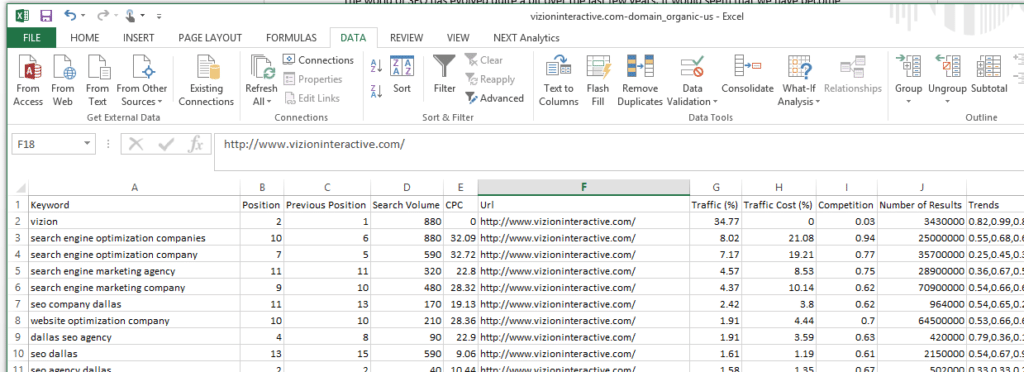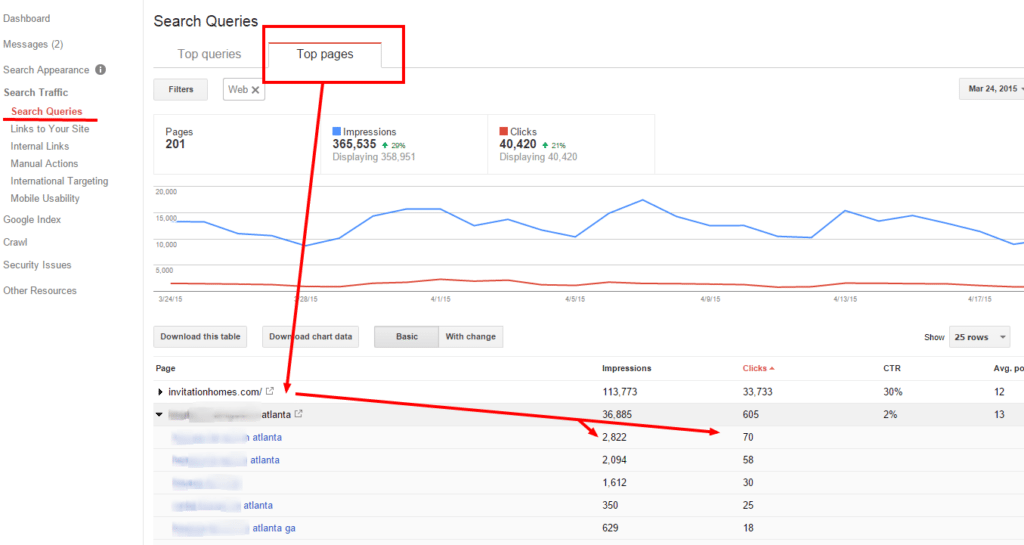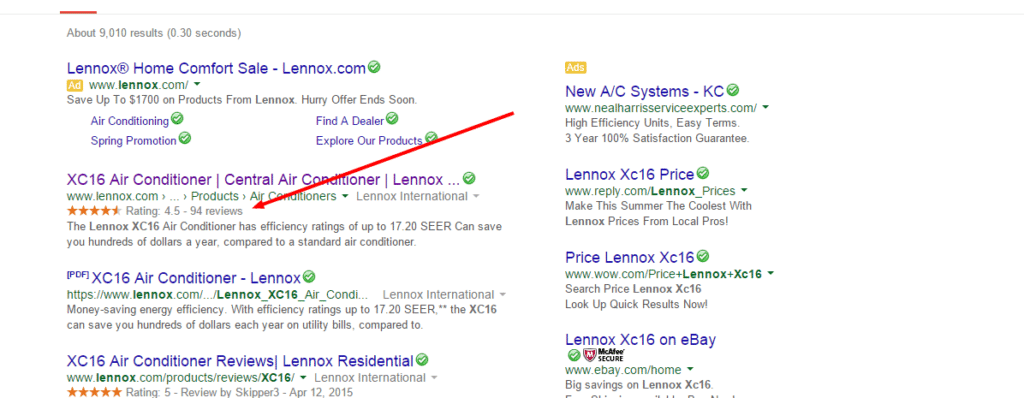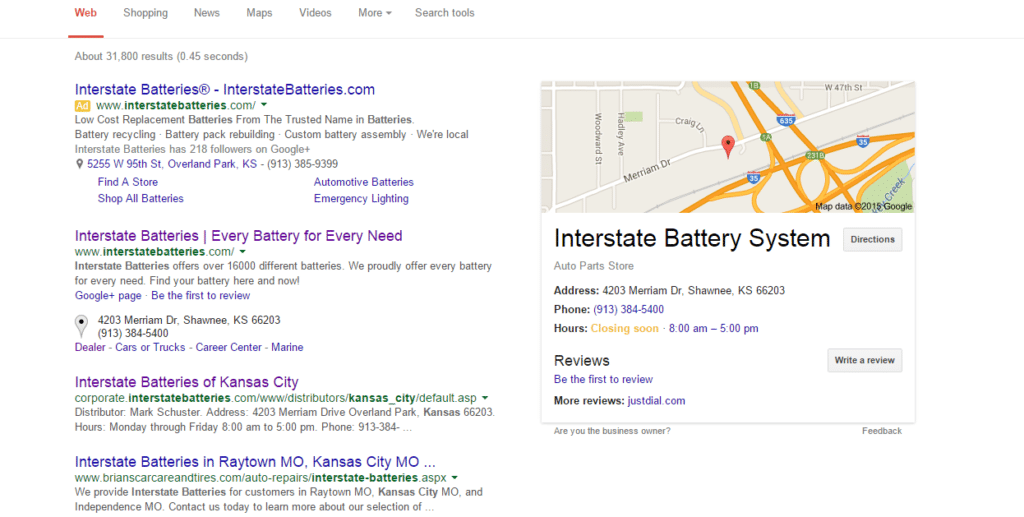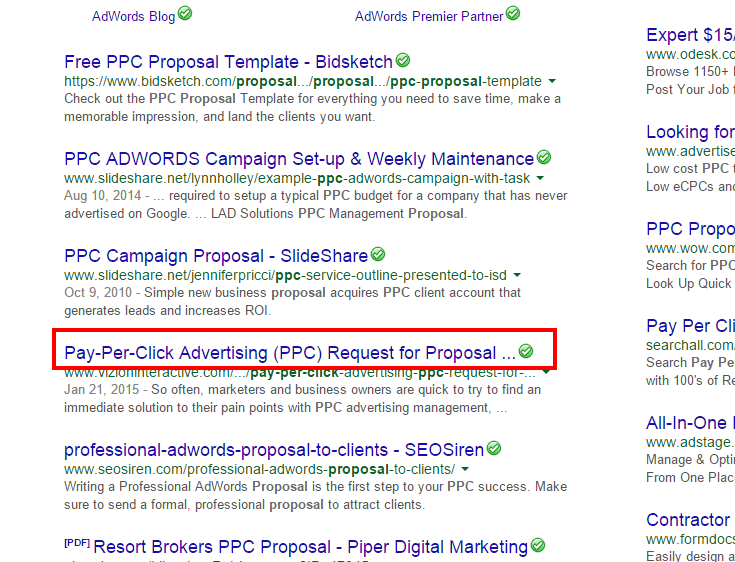The world of SEO has evolved quite a bit over the last few years. We have become absorbed in all that is content marketing, conversion rate optimization, and usability. Don’t get me wrong—I think we are definitely moving in the right direction. We should pay much attention to what the user does once he or she lands on a site. Over time, the organic search marketing segment had become a little too obsessed with keyword ranking placement.
However, even though we have to manage many more irons in the fire, we still can’t forget to analyze our organic footprint from time to time and see how we can enhance and grow our search engine results page (SERP) presence.
Keyword Rankings
I suggest that you not fall into the group that proclaims, “Our SEO rocks! We rank for 3,000 keywords!” Just because you rank for a ton of terms in Google doesn’t necessarily mean you have good organic visibility. Throughout this article we will look at several search result elements that reveal that even if you have a lot of organic visibility, you may not be making the most of it.
To begin our analysis, my first suggestion to analyze your organic visibility is to utilize SEMrush to gain a complete understanding of your entire ranking presence.
Perform a search for your domain followed by a click on the Organic Keywords section.
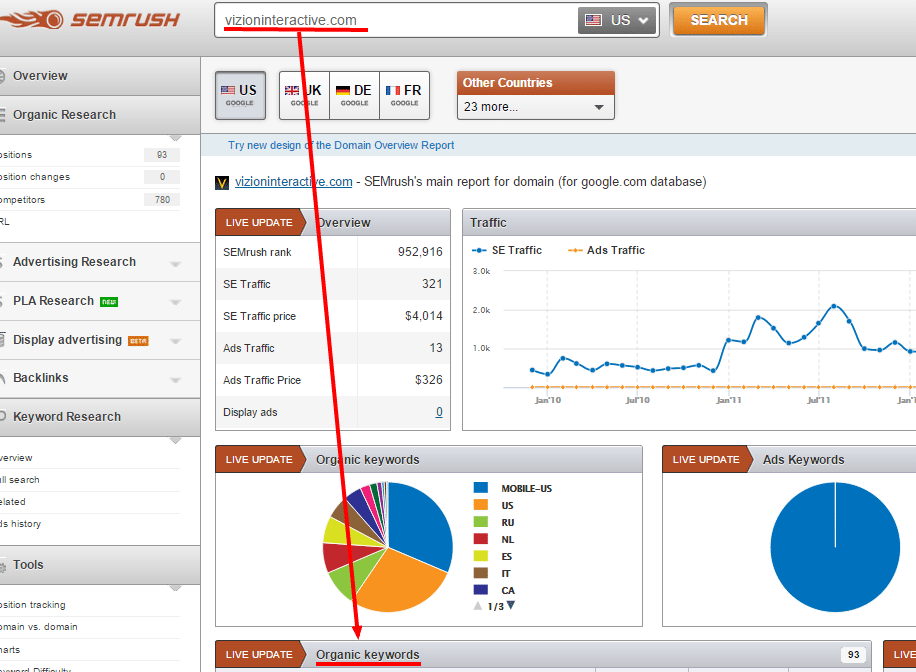
Now, perform an export of this data to an Excel file so that you can gain an understanding of what landing pages/content your domain ranks for.

Once you have extracted this data, you can glean a little more insight into your organic visibility. Sort your ranking landing pages from a few different angles:
Landing Page: This view will allow you to understand what sections of your site comprise the brunt of your organic visibility. While you stood on a pedestal and rejoiced over your thousands of keywords, you may find that the sections of your site that are predominantly ranking may be blog pages or press releases. This is good for exposure, but do these pages generate any revenue? It is likely they do not. If you are finding that you do not see the dominance of ranking pages that you anticipated, this may indicate a need for a technical and on-page SEO review to understand why these pages are not ranking.
Search Volume: Yes, you rank for a large number of terms, but do people search for these terms? While you have a wide keyword breadth, you may be ranking for terms that will not draw many visits. On the other hand, it isn’t a bad idea to rank for long-tail terms that have a lower search volume, as these are often higher-quality visits. However, you should keep a good balance of low- and high-search-volume terms (short tail/long tail).
By-Position: So, the rankings that you are reviewing are for content/pages that you have anticipated that you would see. Maybe you are also seeing that you rank for high-search-volume terms. But are you highly visible? This is why I recommend sorting the list now by both position and search volume. Here we can see what terms have high search volume but also rank well. You will easily be able to pick out your winners that you will want to ensure you retain a presence for. Once you move down the list to second-page rankings (11+), you will begin to see those terms that we deem “near-ranking opportunities.” These terms have a high amount of search volume, are relevant to your site’s objective(s), and yet are on the second page. You are not in the ranking “abyss,” which I deem anything past the third page, but you aren’t quite as visible as the first page yet.
By-Position Grouping: To look at the next view, you could create a pivot chart of ranking positions. However, I prefer to review the SEMrush dashboard. This is because I can take a quick look at our ranking presence over time, but specifically by ranking position group.
From the image above, you can see that I am able to look throughout time, remove my keyword presence from the second page and on, and see how I have been doing regarding positions first through fifth as well as sixth through tenth places.
Competitive Intelligence
While you may think that you have quite a great overall organic visibility, it doesn’t hurt to benchmark yourself in comparison to others. I would strongly recommend performing the aforementioned activities in SEMrush again with your competitors under the lens. Once you get an idea of content/landing page gaps as well as the overall search volume and comparative by-position gap, you can hone in on specific keyword gaps. You can easily do this in the same tool, SEMrush, or in Spyfu. Even if your organic visibility makes you happy, it never hurts for it to grow.
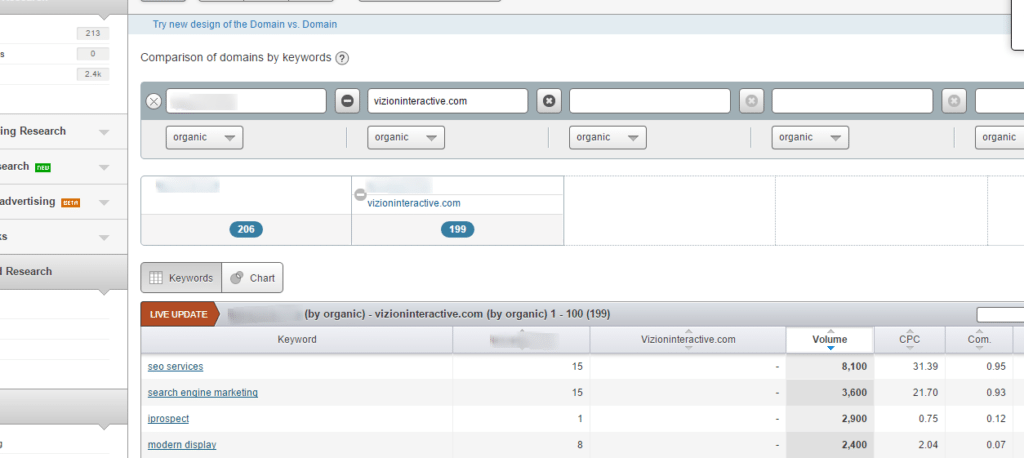
From here you can analyze your competitors’ specific pages and content that are ranking and gain an understanding of the link value and on-page SEO that has led to this success so you can similarly replicate it and close the gap.
Keyword Value
Let us pretend for a moment that up until now you are passing the data analysis checkpoints with flying colors. The content you want to rank is ranking, and it ranks well. As I questioned above in the landing page section, do the ranking pages do anything to support site objectives? You may possibly be ranking for the wrong terms. This is where evolved marketing methodology states that you have to think about keywords based on the buying cycle. Is your well-ranking blog post topically relevant for “buying a bicycle” when the landing page is not a product page but a blog post page? This is probably not going to sell too may bicycles. The post should be about “what type of bicycle is right for me.” This serves someone in the research/information phase and will provide a better entry into the conversion funnel or, at least, a proper introduction to your site/brand.
Next, we will look in Google Analytics at Acquisition>>All Traffic>>Channel>>Organic Search with the Primary Dimension set to Landing Pages. The next thing you will do is sort by your preferred goal so you can see what pages are driving landing page entries that lead to conversions.
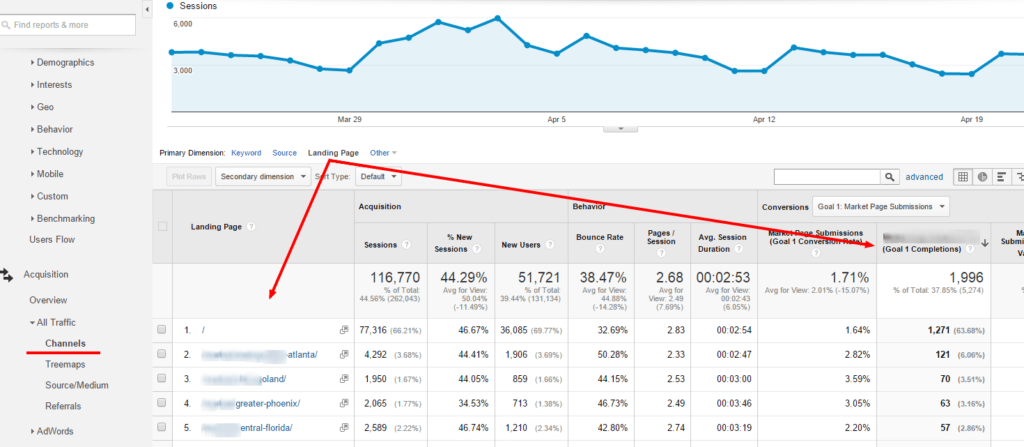
Once you have an understanding of what pages are driving conversions, head over to Google Webmaster Tools and scroll down to the Search Queries section, specifically within the Landing Page segment. Now, you can look at what pages show the most impressions and the top keywords driving impressions for those landing pages.
Remember those pages driving leads in Google Analytics? Once you review these in Google Webmaster Tools, you can get a sense of which terms are likely driving quality and converting traffic. Once again, we come back to the concept that it isn’t always about a huge amount of visibility, but the right visibility.
Search Engine Result Page Display
Up to now, I hope you have gained a basic understanding of what your overall keyword visibility consists of. Now, let’s look at things we can do to enrich your search engine results page (SERP) presence.
Schema Markup: Google prefers to read code on your site in specific coding formats. These are called schemas, and there are now hundreds of approved formats (schema.org). One of the benefits of using schemas is that, in many applications, Google will provide you with a richer SERP display. For example, using the Product/Offer markup schema will take a regular organic listing from ordinary to the below.

You can see that this product page now has price information added, helping you to stand apart from the competition. Another example includes having review schemas for pages of your site that include reviews:
Local Listings: Local search is very important, especially if you have brick-and-mortar locations and also want to attract mobile users. You definitely want to make sure that, at the very least, you have created a Google local listing and populated it with all applicable information. Additionally, this information needs to align with the name/address/phone information on the location pages of your site. Most importantly, link the listing URL to your respective location page on your site.
Sitelinks: While we examined how important it is to work toward building visibility for the non-branded, high-search-volume terms that mean the most to the site objectives of your company, we can’t forget your branded visibility.Perform a branded search in Google and gain an understanding of the first impression you are making for brand searchers.
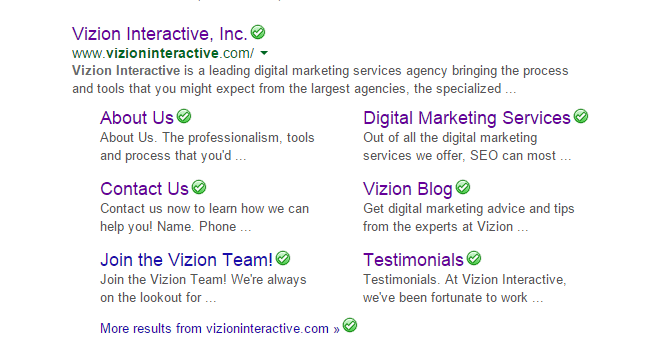
Above, you can see that even though someone searches for my brand, I want him or her to see supplemental site links that are important to my conversion funnel. I want this person to see pages such as testimonials, main services, and contact us. By default, Google will often choose popular pages on your site. Again, popular pages at the moment may not be the ones that mean the most to your bottom line. If this is the case, you can access the Sitelinks segment of Google Webmaster Tools and demote sitelinks that are present in hopes of having a more applicable sitelink appear.
Keep in mind that you can demote and soon remove a sitelink for three months, but you cannot tell Google what you want to appear as a sitelink in its place.
User Behavior
We have had a chance to help improve the SERP display and hopefully understand how we may take advantage of Google offerings to improve our visibility. The last area I want to focus on is user behavior. Earlier in this article I mentioned the need to review search queries in Google Webmaster Tools to pair landing pages with keywords likely to drive traffic and conversions. Take a step back to this process and look at the click-through rate (CTR) of landing pages. Granted, we can’t get a clear picture of CTR by keyword. However, we can understand what pages do have a good or bad CTR. We can also compare the CTR of the landing page as well as the keywords driving impressions and their relevancy to the search result snippet. Now ask yourself if those important keywords are found in the title element and meta descriptions of the respective organic listings.
Conclusion
Hopefully at this point you have learned a little bit more about what constitutes good overall organic visibility. That is great if you are happy with the fact that you rank for a large number of terms. It is imperative though that you perform the above-discussed review to understand where you are visible, whether it is effective, and how you can optimize your organic visibility. Ultimately, organic visibility (aside from branding) nets you little value if it isn’t the right visibility.
At Vizion Interactive, we have the expertise, experience, and enthusiasm to get results and keep clients happy! Learn more about how our SEO Audits, Local Listing Management, Website Redesign Consulting, and B2B digital marketing services can increase sales and boost your ROI. But don’t just take our word for it, check out what our clients have to say, along with our case studies.


